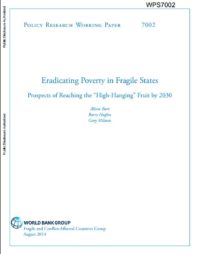
Eradicating Poverty in Fragile States: Prospects of Reaching the “High –Hanging” Fruit by 2030

World Bank Group Summary:
As the world approaches the target year of the Millennium Development Goals and passes into the new, post-2015 era, the development community has made a call for a new international development goal of eradication of extreme poverty by 2030. How feasible is that? For most of the developing world, the goal seems ambitious, yet achievable — but what about the prospects for fragile states in which an increasingly large share of the global poor will live (estimated at nearly four in 10 by 2030)? This paper presents a base case scenario with the International Futures model that forecasts a 32 percent poverty rate for fragile states by 2030 given current conditions and trends. The paper considers alternative scenarios to identify a range of possible outcomes. In the most optimistic scenario, the paper steps beyond the search for realistic policy levers and simply assumes exceptional economic growth and decreased inequality for fragile states. This extremely optimistic scenario produces a forecast of a 20 percent extreme poverty rate for this group of countries. The paper then explores the effects of improved institutions and improved security in fragile states and of a set of poverty reduction policies that would be conditional on security and good governance to be effective. The resulting aggressive but reasonably attainable poverty rate in fragile states is 24 percent in 2030. With newly revised Purchasing Power Parity values (rebased to 2011 by the International Comparison Project in May of 2014), the 2030 forecasts of fragile state poverty rates are lower by 5 to 6 percent across all scenarios, still leaving them significantly above the 3 percent threshold for poverty eradication.
- Issues:
- Demography, Urbanization and Migration, Global and Domestic Governance, Natural Resources
- Region:
- Global
- Year Published:
- 2014
- Authors:
- Alison Burt, Gary Milante, Barry Hughes
- Institution:
- World Bank Group

